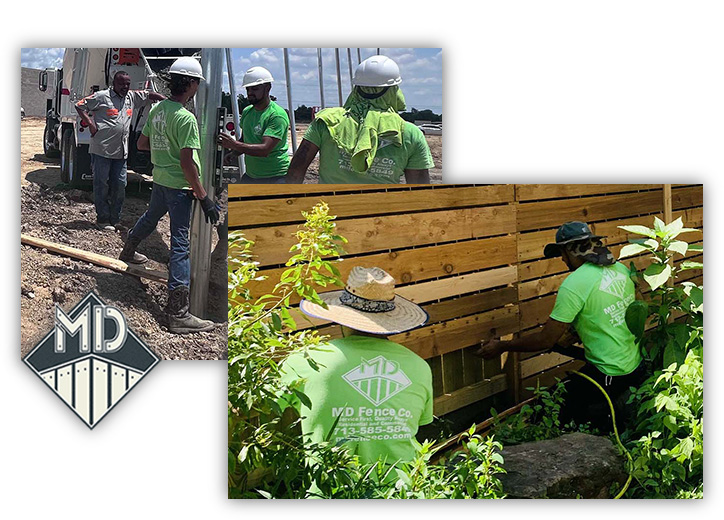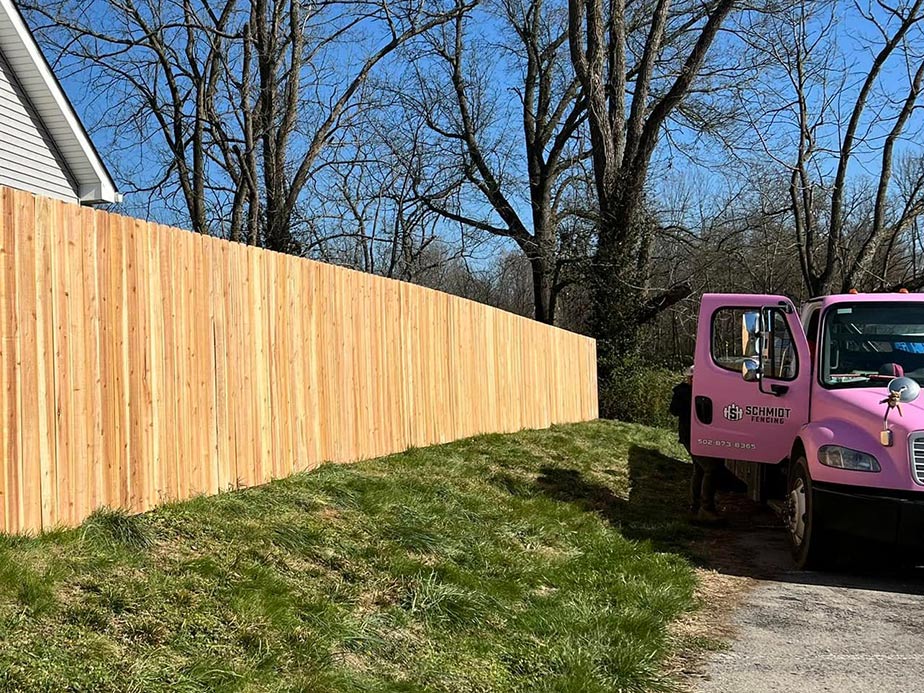How to Find the Right Fence Contractor for Your Backyard Project
How to Find the Right Fence Contractor for Your Backyard Project
Blog Article
Exactly How to Recognize Usual Issues That Require Immediate Fencing Repair
It is vital to find problems before they come to be larger issues when it comes to keeping your fencing. Consistently inspecting for signs of deteriorating timber, leaning panels, or corrosion can save you time and cash in the lengthy run. You might not recognize exactly how weather and bugs can compromise your fence's stability. Let's explore the common indicators that show your fence requires prompt focus, so you can keep your residential property secure and looking its ideal.
Signs of Rotting Timber in Wooden Fences
Have you discovered your wood fence looking a little bit worse for wear? It may be time to check for indications of decaying wood if so. Take a look at the base of the messages and panels for soft places. That's a clear indication of rot if you push on the timber and it really feels spongy or falls apart. Next off, try to find discoloration or dark areas on the timber-- these usually signal dampness damage. Focus on any peeling off paint or surface, as this can reveal the timber to additional decay. Additionally, a poignant, stuffy scent can show fungal development. Don't neglect to evaluate joints and links; if they hang or breaking down, the wood underneath is likely endangered. By catching these indications early, you can prevent more considerable damage and maintain your fencing standing solid. Routine upkeep is essential to extending the life of your wooden fencing.
Leaning or Tilting Fence Panels
If you've noticed your fence panels leaning or turning, it's crucial to comprehend what caused it. This issue might indicate underlying architectural damages that requires your focus. Let's check out the typical causes and the repair work choices available to get your fence back fit.

Reasons For Leaning Panels
It's usually an indication of underlying problems that need addressing when you discover your fence panels tilting or leaning. One common cause is inadequate drain; excessive water can deteriorate the dirt around the fence messages, compromising their support. One more offender might be strong winds or tornados that push versus the panels, particularly if they're not correctly anchored. Furthermore, the natural settling of soil over time can trigger posts to move, resulting in a tilt. Bugs, like termites, can jeopardize the stability of wood panels, causing them to lean also. Poor setup methods might result in panels not being securely established, leaving them vulnerable to leaning under stress. Address these concerns quickly to keep your fence's honesty.
Indicators of Architectural Damage
Discovering tilting or leaning fence panels can be disconcerting, as these problems frequently indicate structural damage that needs prompt attention. When your fence starts to lean, it may indicate that the posts are shifting or that the dirt around them has worn down. Pay close attention to spaces between panels or articles, as these can additionally suggest instability. deck builder. In addition, look for cracks or splintering in the wood, which can damage the overall structure. It could compromise the integrity of the fencing if you see corrosion or rust on metal elements. Bear in mind, overlooking these indications can cause much more extreme damages down the line, so it's necessary to analyze the circumstance promptly and act prior to it intensifies
Repair Work Options Available

Corrosion and Corrosion in Steel Fences
If you own a metal fencing, you may see rust and rust creeping in over time, especially if it's revealed to wetness. These issues not just affect the appearance of your fence however can additionally endanger its architectural honesty. To identify corrosion, look for reddish-brown areas or patches, which show the metal is oxidizing. Deterioration can spread out rapidly if left neglected, leading and compromising the fencing to pricey repairs.To tackle corrosion and deterioration, you should clean the affected areas with a wire brush and apply a rust-inhibiting guide. When the primer dries, take into consideration painting the fence with a weather-resistant paint to secure it further. Regular upkeep, such as inspecting for indicators of corrosion and retouching paint as required, will certainly aid expand your fencing's lifespan. Resolving these problems quickly guarantees your metal fence continues to be strong and aesthetically appealing for several years ahead.
Cracks and Divides in Vinyl Fence

Causes of Plastic Damage
Plastic fence is preferred for its sturdiness, yet it can still experience cracks and divides as a result of various factors. One major reason is severe temperature level variations. It can deteriorate the material over time when plastic broadens in the warmth and agreements in the cool. Additionally, direct exposure to extreme sunshine can bring about UV destruction, making the vinyl weak. Physical influences, like hefty branches or unexpected crashes, can likewise create fractures. Poor setup or utilizing low-grade products can intensify these problems. Furthermore, age plays a duty; older vinyl fencing is more vulnerable to damages. Normal assessments can assist you recognize these aspects prior to they cause significant troubles. Take proactive steps to guarantee your fencing remains intact and strong.
Repairing Cracks Successfully
Although fractures and divides in your plastic fencing can be worrying, addressing them immediately can stop further damages and keep the fencing's appearance. Initially, evaluate the size of the crack. For small cracks, a vinyl repair package usually includes glue that can bond the edges, supplying a smooth solution. Tidy the location completely prior to using the adhesive, guaranteeing it adheres properly. For larger divides, you may require to make use of a vinyl spot. Cut the patch to dimension, use glue around the edges, and press it strongly onto the split. Permit it to cure based on the producer's guidelines. Routine upkeep and quick repairs can prolong your fence's life expectancy, keeping it looking excellent for years to come.
Loose or Missing Fencing Messages
Loosened or missing fencing messages can threaten the security of your entire fencing structure. It's essential to address the issue promptly if you observe any type of articles leaning or tottering. Examine for any indications of movement, as this can bring about more damages with time. You can easily assess the trouble by offering each message a gentle shake-- if it feels unstable, it's time to take action.For missing articles, you'll need to change them as soon as possible to keep your fence's stability. When you install brand-new posts, make certain they're securely secured in the ground with concrete or gravel for included stability. If a message is loose, tighten it by adding added support or driving it deeper into the ground.Ignoring these concerns can result in bigger problems, like voids in your fencing and even full collapse. So, watch on your messages and remain positive regarding repair work!
Damage From Weather Condition and Natural Elements
Weather condition and natural environments can create chaos on your fence, bring about numerous kinds of damage that call for punctual interest. Hefty rainfall can trigger wood to rot, making it unsteady and weak. Snow buildup may flex or damage panels, while solid winds can root out fence messages or cause sections to lean.If you observe splits or splintering in wooden fencings, it signifies drying out as a result of intense sun exposure. Metal fences can rust if safety coatings wear off, especially in humid or coastal areas.Inspect your fencing on a regular basis after tornados or severe weather to capture any type of damages early. Dealing with these issues get more info quickly can save you from expensive fixings down the line. Do not wait until a tiny problem becomes a major one; stay positive and maintain your fence in leading shape to maintain both capability and aesthetic allure.
Insect Invasion and Termite Damage
It's essential to act quickly to avoid more destruction when you discover indicators of bug invasion or termite damage. Search for mud tubes along your fence or hollow-sounding timber, as these show termites go to job. You could additionally see small holes or frass, which is termite droppings resembling sawdust. If you identify any one of these indications, it's time to examine the damage.Don' t wait till it's as well late; bugs can compromise your fencing's stability. Inspect the surrounding area for beetles or ants, as they may be adding to the trouble. If you think an infestation, take into consideration calling a parasite control specialist to confirm and treat the issue.Repairing or changing afflicted areas of your fence quickly not only recovers its toughness but also avoids bugs from spreading further. Remain alert to maintain your property pest-free and safe.
Regularly Asked Questions
Exactly how Usually Should I Check My Fencing for Damages?
You ought to evaluate your fencing at the very least two times a year, preferably during springtime and autumn. Normal checks assist you detect damages early, conserving you time and cash on repair services while preserving your building's look and protection.
Can I Fix a Fence Myself or Employ a Specialist?
If you have the right tools and skills, you can most definitely fix a fencing on your own. Employing an expert guarantees quality job and conserves you time, especially for complex repair services or extensive damages.
What Tools Are Needed for Basic Fencing Fixings?
For basic fence repairs, you'll need tools like a hammer, screwdriver, pliers, a saw, a level, and gauging tape. deck builder. Relying on the repair work, you could additionally require nails, screws, or replacement boards
Just How Much Does Fencing Fixing Commonly Expense?
Fence repair service costs differ commonly, yet you can anticipate to pay between $200 and $1,500 relying on materials, labor, and extent of damage. It's smart to get several quotes for the very best deal.
When Is the Ideal Time of Year for Fencing Repair Works?
The most effective time for fencing fixings is throughout moderate climate, normally in springtime or very early loss. You'll avoid severe temperatures, making it much easier to work and ensuring the products set properly for lasting durability (deck builder). Noticing leaning or tilting fence panels can be disconcerting, as these concerns often indicate architectural damages that needs prompt attention. Loosened or missing fence blog posts can weaken the stability of your entire fencing framework. Snow build-up could flex or damage panels, while solid winds can uproot fencing messages or create sections to lean.If you notice splits or splintering in wooden fencings, it's an indication of drying out due to intense sunlight direct exposure. Metal fences can corrosion if safety layers wear off, especially in coastal or moist areas.Inspect your fencing routinely after storms or extreme weather condition to catch any damage early. Fence fixing prices differ widely, but you can anticipate to pay in between $200 and $1,500 depending on products, labor, and level of damages
Report this page